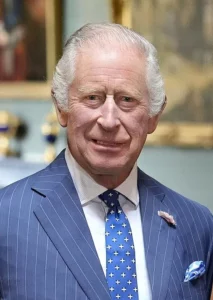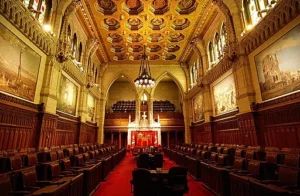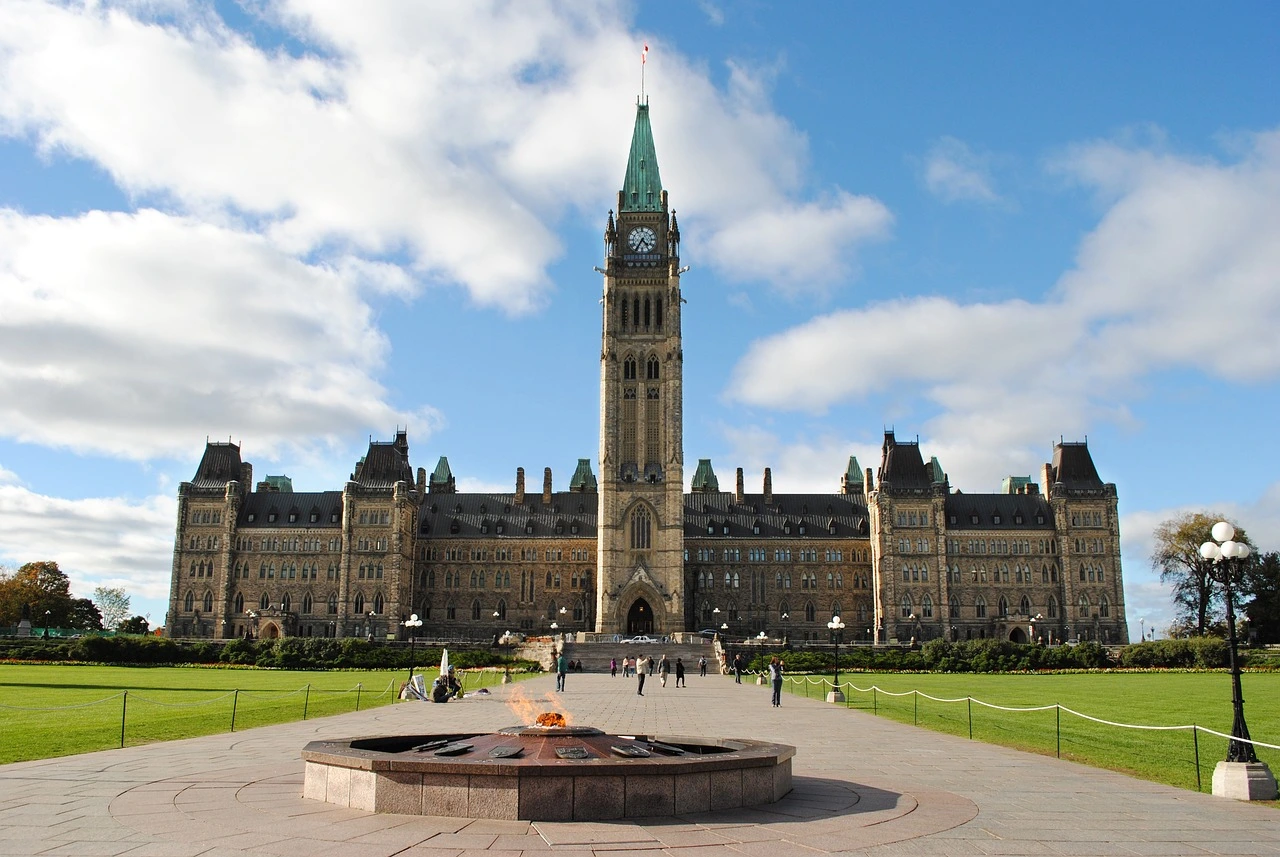At a Glance
- Canada has federal, provincial, territorial, and municipal governments.
- Federal State:
- The federal government handles national and international concerns like defence, foreign policy, interprovincial trade and communications, currency, navigation, criminal law, and citizenship.
- The provinces handle municipal government, education, health, natural resources, property and civil rights, and highways.
- Both the federal government and the provinces share jurisdiction over agriculture and immigration.
- Every province has its own elected Legislative Assembly.
- Parliamentary Democracy:
- Canadians elect members to the House of Commons in Ottawa and to the provincial and territorial legislatures.
- These representatives are responsible for passing laws, approving and monitoring expenditures, and keeping the government accountable.
- Cabinet ministers must retain the “confidence of the House” and resign if they are defeated in a non-confidence vote.
- Parliament consists of the Sovereign (Queen or King), the Senate, and the House of Commons.
- The Prime Minister selects the Cabinet ministers and is responsible for the operations and policy of the government.
- Constitutional Monarchy:
- Canada’s Head of State is a hereditary Sovereign (Queen or King), who reigns in accordance with the Constitution: the rule of law.
- The Sovereign is a part of Parliament, playing an important, non-partisan role as the focus of citizenship and allegiance.
- As Head of the Commonwealth, the Sovereign links Canada to 53 other nations that cooperate to advance social, economic and cultural progress.
- There is a clear distinction in Canada between the head of state—the Sovereign—and the head of government—the Prime Minister.
- The Sovereign is represented in Canada by the Governor General, who is appointed by the Sovereign on the advice of the Prime Minister, usually for five years.
- In each of the ten provinces, the Sovereign is represented by the Lieutenant Governor, who is appointed by the Governor General on the advice of the Prime Minister.
- Each provincial and territorial government has an elected legislature where provincial and territorial laws are passed.
- In each province, the Premier has a role similar to that of the Prime Minister in the federal government.
- Making Laws:
- A bill becomes law after it goes through seven steps: First Reading, Second Reading, Committee Stage, Report Stage, Third Reading, Senate review, and Royal Assent.
How Canadians Govern Themselves
Canada’s governance structure is characterized by three fundamental elements: it operates as a federal state, functions under a parliamentary democracy, and upholds a constitutional monarchy.
Federal State
Canada’s governance structure comprises federal, provincial, territorial, and municipal levels. The Constitution Act of 1867, formerly known as the British North America Act, delineates the responsibilities of the federal and provincial governments.

Statute enacted by the Parliament of the United Kingdom of Great Britain and Northern IrelandPublished by Hunter, Rose in Ottawa, Public domain, via Wikimedia Commons
In this federated system, the federal government is accountable for areas of national and international significance. This includes defense, foreign policy, interprovincial trade and communications, currency, navigation, criminal law, and citizenship.
Conversely, provinces oversee municipal government, education, healthcare, natural resources, property and civil rights, and highways.
Both the federal government and provinces share authority over agriculture and immigration.
This federalist approach enables provinces to implement policies that cater to their specific populations and encourages them to innovate with new ideas and policies.
Each province has its own elected Legislative Assembly, akin to the House of Commons in Ottawa. The three northern territories have smaller populations and do not possess provincial status. However, their governments and assemblies perform many similar functions.
Parliamentary Democracy
In Canada’s system of parliamentary democracy, citizens elect representatives to both the federal House of Commons in Ottawa and to the legislatures of provinces and territories.
These elected officials are tasked with enacting laws, overseeing and approving expenditures, and holding the government accountable. Cabinet ministers are accountable to these elected representatives and must maintain their “confidence”. If they lose a non-confidence vote, they are required to resign.
The Parliament is tripartite, consisting of the Sovereign (the Queen or King), the Senate, and the House of Commons. Provincial legislatures are made up of the Lieutenant Governor and the elected Assembly.

The White House, Public domain, via Wikimedia Commons

Mightydrake, CC BY 3.0, via Wikimedia Commons

Photo by Montrealais, CC BY-SA 3.0, via Wikimedia Commons
At the federal level, the Prime Minister, who selects the Cabinet ministers, is responsible for government operations and policy.
The House of Commons is a representative body composed of Members of Parliament who are elected by the public, typically every four years.
Senators are appointed by the Governor General based on recommendations from the Prime Minister and serve until they reach 75 years of age. Both the House of Commons and the Senate review and consider bills (proposed new laws). A bill can only become law in Canada after it has been approved by both chambers and received royal assent from the Governor General, who acts on behalf of the Sovereign.
As residents of a democratic nation, Canadian citizens have both the right and responsibility to participate in decision-making processes that impact them. It is crucial for Canadians who are 18 years or older to exercise their democratic rights by voting in federal, provincial or territorial, and municipal elections.
Making laws
The Journey of a Bill to Law — The Legislative Procedure
Step 1: First Reading — The bill is read for the first time and subsequently printed.
Step 2: Second Reading — The principle of the bill is debated among members.
Step 3: Committee Stage — Members of the committee scrutinize the bill, examining it clause by clause.
Step 4: Report Stage — At this stage, members have the opportunity to propose additional amendments.
Step 5: Third Reading — Members engage in a debate and subsequently vote on the bill.
Step 6: Senate Review — The bill undergoes a similar procedure in the Senate.
Step 7: Royal Assent — After being approved by both Houses, the bill receives royal assent.
Constitutional Monarchy
Canada, a constitutional monarchy, has a hereditary Sovereign as its Head of State. This Sovereign, either a Queen or King, reigns in accordance with the Constitution and the rule of law.
The Sovereign is an integral part of Parliament and plays a crucial, non-partisan role as the focus of citizenship and allegiance, especially during royal visits to Canada. The Sovereign symbolizes Canadian sovereignty, safeguards constitutional freedoms, and reflects our history.
The Royal Family’s lifelong service to the community inspires citizens to contribute their best to their country. As the Head of the Commonwealth, the Sovereign connects Canada with 53 other nations that collaborate to promote social, economic, and cultural progress. Other countries with constitutional monarchies include Denmark, Norway, Sweden, Australia, New Zealand, The Netherlands, Spain, Thailand, Japan, Jordan, and Morocco.
In Canada’s governance structure, there is a clear distinction between the head of state—the Sovereign—and the head of government—the Prime Minister who actually oversees the country’s governance.
The Sovereign’s representative in Canada is the Governor General who the Sovereign appoints on the advice of the Prime Minister for a usual term of five years.
Similarly, in each of the ten provinces, the Lieutenant Governor represents the Sovereign. The Governor General appoints them on the advice of the Prime Minister for typically five years.
The interaction between the three branches of government — the Executive, Legislative and Judicial — ensures the rights and freedoms of Canadians. They work together but also sometimes in creative tension.
Each provincial and territorial government has an elected legislature where provincial and territorial laws are passed. The members of these legislatures are known as members of the Legislative Assembly (MLAs), members of the National Assembly (MNAs), members of Provincial Parliament (MPPs), or members of House Assembly (MHAs), depending on their province or territory.
In each province, there is a Premier whose role is similar to that of the Prime Minister at the federal level. Similarly, the Lieutenant Governor’s role in each province mirrors that of the Governor General at a federal level.
In all three territories, a Commissioner represents the federal government and performs ceremonial duties.
Frequently Asked Questions
What are the three key facts about Canada’s system of government?
The three key facts are: Canada is a federal state, a parliamentary democracy, and a constitutional monarchy.
What are the different levels of government in Canada?
Canada’s governance structure comprises federal, provincial, territorial, and municipal levels.
What is the Constitution Act of 1867?
The Constitution Act of 1867, formerly known as the British North America Act, delineates the responsibilities of the federal and provincial governments.
What responsibilities does the federal government have in Canada’s federated system?
The federal government is accountable for areas of national and international significance. This includes defense, foreign policy, interprovincial trade and communications, currency, navigation, criminal law, and citizenship.
What responsibilities do provinces have in Canada’s federated system?
Provinces oversee municipal government, education, healthcare, natural resources, property and civil rights, and highways.
Which areas of governance do the federal government and provinces share?
Both the federal government and provinces share authority over agriculture and immigration.
What is the role of a province’s Legislative Assembly?
Each province has its own elected Legislative Assembly, akin to the House of Commons in Ottawa.
How do the northern territories fit into Canada’s governance structure?
The three northern territories have smaller populations and do not possess provincial status. However, their governments and assemblies perform many similar functions.
What is Canada’s parliamentary democracy?
Citizens elect representatives to the federal House of Commons and provincial/territorial legislatures.
What do Cabinet ministers do?
They are accountable to elected representatives and resign if they lose a non-confidence vote.
What makes up Parliament?
It consists of the Sovereign, Senate, and House of Commons. Provincial legislatures include the Lieutenant Governor and Assembly.
Who manages federal government operations?
The Prime Minister, who also selects Cabinet ministers.
How does a bill become law?
It must be approved by both chambers and receive royal assent from the Governor General.
What is the role of Canadian citizens in democracy?
They participate in decision-making processes by voting in elections.
Who elects the Members of Parliament?
They are elected by the public, typically every four years.
How are Senators appointed?
They are appointed by the Governor General based on recommendations from the Prime Minister.
Until what age do Senators serve?
They serve until they reach 75 years of age.
What is royal assent?
It’s the approval granted by the Governor General on behalf of the Sovereign for a bill to become law.
What is the role of the Lieutenant Governor in provincial legislatures?
The Lieutenant Governor is part of the provincial legislature along with the elected Assembly.
What is the term of Members of Parliament?
They are traditionally elected every four years.
What happens during the First Reading of a bill?
During the First Reading, the bill is considered read for the first time and is printed.
What is the purpose of the Second Reading of a bill?
The Second Reading is when members debate the bill’s principle.
What occurs during the Committee Stage of a bill?
During the Committee Stage, committee members study the bill clause by clause.
What is allowed during the Report Stage of a bill?
During the Report Stage, members can make other amendments to the bill.
What happens during the Third Reading of a bill?
The Third Reading is when members debate and vote on the bill.
Does a bill go through a similar process in the Senate?
Yes, after the Third Reading, the bill follows a similar process in the Senate.
What is Royal Assent in the legislative process?
Royal Assent is when the bill receives approval after being passed by both Houses.
What is the form of government in Canada?
Canada is a constitutional monarchy.
Who is the Head of State in Canada?
The Head of State in Canada is a hereditary Sovereign, either a Queen or King.
What is the role of the Sovereign in Canada?
The Sovereign plays an important, non-partisan role as the focus of citizenship and allegiance, most visibly during royal visits to Canada. They are a symbol of Canadian sovereignty, a guardian of constitutional freedoms, and a reflection of Canadian history.
Who was the 28th Governor General since Confederation in Canada?
The 28th Governor General since the Confederation of Canada was David Johnston.
What is the role of the Royal Family in Canada?
The Royal Family’s lifelong service to the community inspires citizens to contribute their best to their country.
Who is the head of government in Canada?
The head of government in Canada is the Prime Minister.
Who represents the Sovereign in Canada and how are they appointed?
The Sovereign’s representative in Canada is the Governor General who the Sovereign appoints on the advice of the Prime Minister for a usual term of five years.
Who represents the Sovereign in each province and how are they appointed?
In each of the ten provinces, the Lieutenant Governor represents the Sovereign. They are appointed by the Governor General on the advice of the Prime Minister for typically five years.
What are the three branches of government in Canada?
The three branches of government in Canada are Executive, Legislative, and Judicial.
What is the role of the Premier in each province?
In each province, there is a Premier whose role is similar to that of the Prime Minister at the federal level.
What is the role of the Lieutenant Governor in each province?
The Lieutenant Governor in each province has a role similar to that of the Governor General at a federal level.
Who represents the federal government in the territories?
In all three territories, a Commissioner represents the federal government and performs ceremonial duties.
What are the members of the provincial and territorial legislatures called?
The members of these legislatures are known as members of the Legislative Assembly (MLAs), members of the National Assembly (MNAs), members of Provincial Parliament (MPPs), or members of House Assembly (MHAs), depending on their province or territory.
What is the role of the Sovereign in the Commonwealth?
As the Head of the Commonwealth, the Sovereign connects Canada with 53 other nations that collaborate to promote social, economic, and cultural progress.
Which countries have constitutional monarchies like Canada?
Other countries with constitutional monarchies include Denmark, Norway, Sweden, Australia, New Zealand, The Netherlands, Spain, Thailand, Japan, Jordan, and Morocco.



Leave a Reply